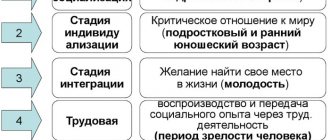In this article we will tell you:
- Stress concept
- Psychological theories of stress
- Types of stress conditions
- Psychological causes of stress
- Stages (phases) of stress
- Psychodiagnostics of stress/Symptoms of stress
- Methods for mild correction of stress
- Prevention of stress conditions
Psychology of stress - why is it important to know as much as possible about it? It's simple. The pace of life has become increasingly faster lately, and stress – both physical and psychological – is constantly growing. It is not surprising that being in a permanent state of stress has become almost the norm for many people.
Stress concept
Stress is a nonspecific response of the body to any change in conditions that requires adaptation. In simple words, some changes in the external environment require us to adapt. It got colder outside, warmer, we moved to a different climate, met other people - all this requires physical and mental effort from us. In general, this phenomenon can be described as stress. If adaptation occurs, it means there is stress.
The concept of stress is translated as load, tension, pressure, a state of increased tension, and it is so. But not every state of tension is stress. Only when you need to turn on the body's reserves for adaptation.
Stress is our internal mechanism of adaptation of the body and its way of survival.
If a person steps on glass with his heel, a stress response will begin in his body. That is, stress is an adaptation mechanism itself. The body begins to make some changes in order to adapt to this situation. He notices that there is glass in the heel, thickens the blood so that it begins to clot and prevent blood loss.
But if the system of reactions to stress and attempts to adapt to it remains turned on for too long, this leads to illness.
Stress is anything that disrupts our homeostatic balance. Homeostasis is the body’s self-regulation system, which allows us to maintain consistency within our systems. Usually here we are talking about maintaining body temperature, blood glucose levels, approximately the same blood pressure and various other processes within the body.
When stress somehow upsets our balance, the body, with the help of neurotransmitters, hormones, and the nervous system, tries to adapt to this and restore balance back.
If, in the case of animals, stress is only a violation of the homeostatic balance that already exists at a given time, i.e. This is a factor that is affecting right now, then everything is more complicated with a person. When a wild dog Dingo grabs a jerboa by the spine, this is a stress factor for him. In the case of a person, everything is different; it may also be the thought that the homeostatic balance may be disturbed, that is, this is not stress itself, not the stress factor itself, but thoughts about what could happen.
SAVELIEV'S LIPID DISTRESS SYNDROME: 20 YEARS LATER V.A. Petukhov, corresponding member. RANS prof. M.S. Magomedov, Ph.D. Department of Faculty Surgery of the Russian State Medical University (head of the department - academician of the Russian Academy of Sciences and the Russian Academy of Medical Sciences, Prof. V.S. Savelyev) and the First City Hospital of Moscow (chief physician - Prof. O.V. Rutkovsky) Twenty years ago, in the clinic of faculty surgery of the Russian State Medical University, headed by Academician of the Russian Academy of Sciences and the Russian Academy of Medical Sciences, Professor V.S. Savelyev, on the basis of the First City Hospital named after. N.I. Pirogova (chief physician - Professor O.V. Rutkovsky) performed the first partial ileal bypass surgery to correct hyperlipidemia in obliterating atherosclerosis. In the next 10 years, many similar surgical interventions were performed to normalize lipid metabolism with good clinical effect. But then we completely abandoned surgical treatment of hyperlipidemia. To answer the question: “Why was this decision made?” this message is dedicated to. Over the years, a fundamentally new approach to the diagnosis and treatment of many diseases caused by disorders of lipid metabolism has been developed and the concept of Savelyev’s lipid distress syndrome has been formed as a systemic pathological reaction of the body based on lipid metabolism disorders in the form of numerous pathobiochemical, pathophysiological and pathomorphological processes that go beyond specific affected target organ, contributing to the emergence of new or progression of existing diseases. The patterns of development of disorders established in Savelyev's lipid distress syndrome (LDS) do not depend on nosology and relate to pathological processes common to all diseases, the basis of which is dyslipoproteinemia, endotoxemia and endothelial dysfunction. LDS is always formed against the background of lipid metabolism disorders - dyslipoproteinemia. The basis of cholesterol homeostasis is the enterohepatic circulation of bile acids. Primary bile acids are synthesized in hepatocytes from cholesterol and are synthesized into bile as part of a conjugate with glycine and taurine. In the small intestine, under the influence of numerous digestive enzymes, deconjugation of bile acids occurs. Bile salts are formed, which participate in the formation of micelles necessary for the absorption of fats. After absorption of fats, bile acids remain in the cavity of the small intestine and, through a feedback mechanism, are absorbed in the ileum into the blood (about 85–90% of bile acids released into the intestine as part of bile). Bile acids absorbed in the small intestine are transported with the blood through the portal vein to the liver and, after certain metabolic processes, are again included in the composition of bile. The remaining 10–15% of bile acids are excreted from the body mainly in feces. This physiological loss of bile acids is replenished by their compensatory synthesis in hepatocytes, for which cholesterol from blood plasma and other reserves is used. Changes in the lipid composition of the blood always occur against the background of deep microecological disturbances in the intestines. Microorganisms of the gastrointestinal tract actively interfere with cholesterol metabolism, acting directly on the enzyme systems of host cells involved in the recycling of bile acids and synthesizing endogenous cholesterol. Increased proliferation of bacteria in the small intestine due to dysbiosis of the gastrointestinal tract against the background of stress (psycho-emotional, medicinal, chemical, etc.) leads to increased deconjugation of bound bile acids and the formation of their toxic endogenous salts, disrupting microcirculation in the intestinal wall, increasing absorption and return to the liver of almost 100% of the bile acids released into the lumen of the small intestine. In the liver, according to the “feedback” principle, the synthesis of bile acids in hepatocytes compensatory decreases, as a result of which the cholesterol content in the blood plasma increases due to the absence of the need to replenish daily physiological losses (fecal excretion) of bile acids and cholesterol in the disrupted enterohepatic circulation cycle. Thus, disruption of the main natural mechanism of cholesterol homeostasis, the enterohepatic circulation of bile acids, is the basis for the formation of dyslipoproteinemia and lipid distress syndrome. When enterohepatic circulation is disrupted, a significant deficiency of bile acids in the intestine is created. In the small intestine, a lack of bile acids contributes to the development of impaired absorption and digestion of food - indigestion syndrome. In the colon, a lack of bile acids, in addition to numerous metabolic disorders, leads to a decrease in the “sterilizing properties of bile.” The result is the progression of dysbiosis in the large intestine, fermentation, dysfunction of the bauginium valve and increased microbial contamination of the small intestine on the one hand, and on the other hand an increased amount of endotoxin from gram-negative microflora entering the liver with the blood. In the colon, under conditions of dysbiosis, the synthesis of volatile fatty acids, the main mechanism in the water-electrolyte, acid-base and energy balance of the human body, is significantly reduced. The activity of the digestive-transport conveyor is disrupted. Indigestion syndrome is formed. A “vicious circle” closes: dysbiosis – disruption of the enterohepatic circulation of bile acids – decreased synthesis of bile acids and their entry into the intestines – dysbiosis. Treatment strategy The treatment strategy for Saveliev's lipid distress syndrome is based on strict adherence to the following principles: 1. treatment is based on the correction of lipid metabolism disorders, reduction of endotokineemia and elimination of endothelial dysfunction; 2. treatment of dyslipoproteinemia should always be long-term (sometimes lifelong); 3. treatment of dyslipoproteinemia must be safe for the patient; 4. Treatment of dyslipoproteinemia can be independent and (or) combined with any intervention on the target organ. Treatment tactics Therapeutic effects are carried out simultaneously in the following areas: restoration of the normal functioning of the physiological mechanism for regulating lipid metabolism in the body - enterohepatic circulation of bile acids; restoration of impaired metabolic functions of the liver (synthesis of bile in hepatocytes and transport of bile from hepatocytes); elimination of extrahepatic biliary dysfunctions; activation of the reticuloendothelial system of the liver; removal of endotoxin from intestinal contents; decreasing the concentration of endotoxin in the blood; elimination of endothelial dysfunctions; elimination of intestinal dysbiosis. Correction of lipid metabolism disorders The physiological metabolism of cholesterol in the body is restored by conservative blockade of the enterohepatic circulation of bile acids. An important condition for the effectiveness of the blockade is the normalization of the processes of bile synthesis in the liver and its adequate flow into the intestines. Blockade of the enterohepatic circulation of bile acids is no alternative method of treating lipid metabolism disorders for the following reasons. Firstly, the enterohepatic circulation of bile acids is the only natural mechanism of cholesterol homeostasis that provides control over the cholesterol content in the blood plasma throughout a person’s life. Secondly, a unidirectional pharmacological decrease in the concentration of cholesterol in the blood plasma is effective only at first; long-term use of drugs (suppression of cholesterol synthesis in hepatocytes) is always accompanied by numerous metabolic complications. Thirdly, during the formation of lipid distress syndrome, the liver becomes the main target organ, so one cannot count on its adequate metabolic response (decrease in cholesterol concentrations) with the involvement of impaired enzyme systems of hepatocytes in any pharmacological treatment of dyslipoproteinemia; it is necessary to restore impaired physiological regulatory functions. With a physiological blockade of the enterohepatic circulation of bile acids, the time they remain in the hepatic-intestinal circulation is reduced, the synthesis of bile acids in the liver is stimulated, for this purpose their metabolism from cholesterol entering the liver is sharply intensified, i.e., the level of total cholesterol and atherogenic lipoproteins decreases in blood plasma. After a certain time, this promotes the entry into the blood and further into the liver (with subsequent transformation into bile acids) of cholesterol from organs and tissues, including arteries, the wall of the gallbladder, liver, pancreas and is the basis for decholesterolization of any target organ. Digestive processes involving bile during blockade of the enterohepatic circulation of bile acids are not disrupted; on the contrary, they are significantly intensified. A means for conservative blockade of enterohepatic circulation of bile acids – enterosorbent FISHant-ST. The drug is produced (Moscow, Russia) (permit of the Ministry of Health of Russia No. 77.99.23.3.U.11600.10.06; sanitary-epidemiological conclusion of the Federal Service for Surveillance on Consumer Rights Protection and Human Welfare No. 77.99.03.003.T.002070.10.06 dated 31.10 .06 on compliance with state sanitary and epidemiological rules and regulations) in paste and liquid forms. The abbreviation “FISH” in the name of the enterosorbent means “Physiological IleoBunting”, “S” is the first letter of the surname of the author of the drug (Savelyev). FISHant-ST is the first representative of a new class of enterosorbents, which is a composition of biologically inert components (white oil) and prebiotics (pectin, agar-agar) in the form of a complex encapsulated microemulsion. It is arranged as follows (Fig. 1).Inside a microcapsule (polysaccharide membrane) 0.1 microns in size made of pectin and agar-agar there is white oil (the purest fraction of petroleum jelly). An emulsion consisting of a huge number of such microcapsules has excess surface energy and at the same time is thermodynamically stable (does not collapse) in acidic and alkaline environments, with increasing temperature or upon cooling. In addition, the excess surface energy of the microemulsion activates numerous enzymatic systems of the body. Comparison of the effectiveness of common lipid-lowering drugs, including various statins, ezitimibe, fibrates, ion exchange resins and FISHant-ST, revealed the advantages of oil-pectin microemulsion. They consisted of a significant biochemical effect and the absence of contraindications and complications during long-term (10 years or more) treatment. In addition, the levels of reduction in plasma lipids during treatment with FISHant-ST were comparable to those during surgical blockade of the enterohepatic circulation of bile acids by partial ileal bypass surgery. The high clinical effectiveness and absolute absence of complications in treatment with enterosorbent FISHant-ST is explained by the drug’s neutral components for the body (white oil - a specially selected narrow fraction of petroleum jelly and seaweed agar-agar) and the ability to completely restore the disturbed physiological balance of cholesterol using a unique natural blockade mechanism enterohepatic circulation of bile acids. The physiology of the conservative blockade of the enterohepatic circulation of bile acids using the enterosorbent FISHant-ST is explained by the fractional (once a week) use of a “blocking agent” at intervals that allows maintaining full absorption of food ingredients, minerals, trace elements and vitamins in the gastrointestinal tract. Mechanism of action of enterosorbent FISHant-ST Enterosorbent FISHant-ST after oral administration is mixed with chyme and “lubricates” the small intestine, covering it with a thin film. Then, using two mechanisms (passive and active), it temporarily (for 24–26 hours) blocks the reabsorption of bile acids, interrupting their enterohepatic circulation. The first mechanism (passive) - a thin film of microemulsion prevents the absorption of bile acids in the wall of the small intestine. The second mechanism (active) - FISHant-ST) absorbs bile acids well: they are easily transported through the pectin-agar (polysaccharide) membrane of the enterosorbent micelle, dissolved in white oil and transported inside the microcapsule to the colon, where they are integrated into the physiological metabolic cascade with the indispensable participation microflora enzymes. There, microorganisms use pectin and agar-agar as a food (metabolic) substrate, the microemulsion is partially destroyed and a certain amount of bile acids dissolved in the oil enters the lumen of the colon. Let us recall that for the colon, bile acids are an extremely important and necessary metabolic substrate, participating in the “getting rid” of the microflora of this part of the intestine from pathological strains, serve as a food substrate for resident species of microorganisms and, in general, together with the prebiotics pectin and agar-agar, restore the microbiocenosis of the colon and its motility. White oil helps soften stool and normalize stool. Pectin, which forms the basis of the microemulsion, is also involved in the normalization of lipid metabolism. Its inability to be broken down and absorbed in the small intestine, associated with resistance to the action of amylase and other enzymes, provides a unique biological effect based on the formation of a fibrous and amorphous matrix, in particular, of the “amorphous sieve” type. Enterosorbent FISHant-ST perfectly absorbs and removes from the body various endotoxins from the microflora of the gastrointestinal tract and heavy metals that enter with food. When treating lipid distress syndrome with enterosorbent FISHant-ST, simultaneously with the physiological normalization of lipid metabolism, the following occurs: - restoration of metabolic functions of the liver (synthesis and transport of bile); — reduction in the level of systemic endotoxemia; — activation of the reticuloendothelial system of the liver; - normalization of carbohydrate metabolism and reduction in the amount of glycosylated hemoglobin in the blood plasma; — reducing the activity of lipid peroxidation in blood plasma and increasing its antioxidant potential; - normalization of intestinal microbiocenosis (increasing the level of volatile fatty acids, normalizing the species composition - microbiota, reducing the amount of endotoxin in the intestinal contents); — activation of digestive enzymes; — homeostasis of chyme; — elimination of “metabolic chaos” and chronic endotoxin aggression. Advantages of treating lipid distress syndrome with enterosorbent FISHant-ST: restoration and support at the physiological level of the natural mechanism for controlling lipid content in the blood plasma; pronounced metabolic and clinical effects; metabolic safety during long-term treatment; absence of contraindications and complications; financial inclusion. There are no contraindications to the use of enterosorbent FISHant-ST, and no adverse reactions or complications have been identified. FISHant-ST is taken once a week in the morning after a light breakfast for 4–12 months. The duration of treatment is determined by the intensity of the processes of restoration of target organ functions, as well as the normalization of metabolic functions of the liver, microbiotic status of the colon, plasma lipid levels and endotoxin concentration in the blood. Treatment of LDS with the use of enterosorbent FISHant-ST leads to positive structural and functional changes simultaneously in all target organs without exception: the synthesis of bile in the liver is activated and its transport from hepatocytes to the biliary system, the physicochemical properties of the bile itself are normalized, the contractile function of the bile duct is restored bladder, the spastic state of the sphincter of Oddi is eliminated and the flow of bile into the intestines is normalized, which significantly improves the digestive processes; the content of cholesterol esters in the liver (with fatty hepatosis), pancreas (with fatty pancreatosis), in the artery wall (with atherosclerosis), etc. decreases. The resulting correction of endothelial dysfunction significantly improves mesenteric blood flow and blood circulation in the liver, and also prevents the initiation and progression of atherosclerotic changes in the arteries. Treatment of liver dysfunction The pace and intensity of positive morpho-functional changes in target organs and the effectiveness of therapy with enterosorbent FISHant-ST can be increased by including hepatotropic drugs in the basic therapy. In the treatment of liver dysfunction and extrahepatic biliary dysfunctions in lipid distress syndrome, it is necessary to use herbal preparations, since long-term use of synthetic pharmacological analogues always leads to an undesirable hepatotoxic effect. All hepatoprotectors, depending on the leading mechanism of action, are divided into drugs that enhance the production of bile - choleretics, and ensure a sufficient supply of bile from the gallbladder and liver during the digestion process - cholekinetics. One of the representatives of combined hepatoprotective agents of plant origin is the drug hepabeneT, one capsule of which contains 275 mg of Fumaria officinalis extract (Fumaria officinalis) and 70–150 mg of Fructus Sylibi mariani extract (fruits of milk thistle) (50 mg of silymarin and 22 mg of silibinin). The use of hepabeneT in the complex therapy of lipid distress syndrome makes it possible to increase choleresis due to a fraction independent of the amount of bile acids synthesized, to activate the synthesis of endogenous cholecystokinin and secretin, which, as a result of increased secretion of water and bicarbonates by the epithelium of the bile ducts, helps to restore the motor-evacuation function of the gallbladder, reduce neurogenic tone of the sphincter of Oddi, ensuring a greater flow of bile into the intestines and creating all metabolic conditions for the speedy restoration of the mechanism of enterohepatic circulation of bile acids and digestion. Treatment of colon dysbiosis To normalize the microbiocenosis of the colon, probiotics and prebiotics are used separately or in various combinations. Probiotics are live or killed microorganisms or substances of microbial origin (structural components, metabolites) that have a beneficial effect on the physiological functions and biochemical reactions of the body through the optimization of microbiological status. Probiotics based on microbial cell components or metabolites interfere with the metabolic activity of various organs and tissues either directly or indirectly through the regulation of the functioning of biofilms on mucous membranes. The most important specific functions of microorganisms for the intestinal mucosa are the production of nutrient substrates of fatty acids (primarily volatile fatty acids), amino acids, as well as vitamins, antioxidants and amines, which are important for the normal functioning of the entire organism. Hilak-Forte is used to treat dysbiosis in lipid distress syndrome as part of complex pre- and probiotic therapy (synbiotic treatment option). Sterile concentrate of waste products of gram-positive and gram-negative microorganisms - synbionts of the small and large intestines that form lactic acid; amino acids; lactose; short chain fatty acids. Hilak-forteT contains important metabolic products of lactobacilli, Escherichia coli and lactic acid. Treatment of endothelial dysfunction Endothelial dysfunction in Savelyev's lipid distress syndrome plays an important etiopathogenetic role in the development of arterial lesions (atherosclerosis and its complications). It is characterized by an imbalance between relaxation and constriction factors, pro- and anticoagulant substances, and between pro- and anti-inflammatory mediators. Various substances produced by endothelial cells, in addition to their function controlling the cardiovascular system, are also an essential part of the immune system, playing a pilot role in the initiation and development of protective and damaging inflammatory responses. Lipopolysaccharide endotoxin of gram-negative microflora, which enters the systemic circulation in excess quantities during lipid distress syndrome, binds to vascular endothelial cells, in the area of its attachment to the endothelial cell, complement is activated along an unopposed pathway (without the participation of antibodies) with the development of inflammation and damage to the endothelium. Treatment of endothelial dysfunction in lipid distress syndrome is carried out in several directions: 1. removal and neutralization of microbial toxins and inflammatory mediators (enterosorption of endotoxins using FISHant-ST); 2. an increase in the blood plasma concentration of high-density lipoproteins - the main endotoxin-binding elements of the blood (correction of dyslipoproteinemia by restoring the enterohepatic circulation of bile acids); 3. restoration of intestinal microbiocenosis (pre- and probiotic therapy, restoration of transport of bile acids through the intestines); 4. reducing the dysmetabolic consequences of chronic endotoxin aggression in the endothelium. For this purpose, the plant endothelial protector antistaxT is used - a natural extract of red grape leaves containing active flavonoids (quercetin glucuronide and isoquercetin). Antistax stabilizes endothelial cell membranes under conditions of oxidative and endotoxin stress, normalizes endothelial permeability to proteins, plasma and water, low-density lipoproteins and cholesterol esters. The basic algorithm for the treatment of lipid distress syndrome FISHant-ST – once a week – 6 – 12 months; hepabenet – 1 – 2 capsules 3 times a day for 2–6 months (or other herbal hepatoprotective drug); hilak forteT - 40 - 60 drops 3 times a day for 2 weeks, then 15 - 20 drops 3 times a day - 6-8 weeks, then prebiotics, probiotics, synbiotics in various combinations - 6-8 weeks; AntistaxT 2 capsules 1 time per day for 2–3 months 2 times a year.
Thus, Savelyev’s concept of lipid distress syndrome most fully to date reveals the etiopathogenesis of many diseases associated with lipid metabolism disorders and offers a clear scheme for their treatment. If we return to the beginning of the article, it is worth noting that the operation of partial ileobypass, in fact, eliminates only one link - it restores the enterohepatic circulation of bile acids. Endotoxemia, dysbiosis, liver dysfunction and endothelial dysfunction remain outside the therapeutic effects. A conservative analogue of this surgical intervention, physiological blockade with enterosorbent FISHant-ST, completely compensates for this therapeutic deficiency and has great clinical promise.
magazine "Polyclinic No. 2", pp. 90–94, 2007.
Psychological theories of stress
For the first time in 1915, American psychophysiologist Walter Bradford Cannon spoke about a condition that is now associated with the concept of stress, and called this reaction “fight or flight”. And he even described this phenomenon in the book “Body changes during pain, hunger, fear and anger.” The year 1915 can be considered the beginning of the European and American approach to this topic.
We recommend
“Nutrition for a healthy lifestyle: healthy foods, life hacks, menus” Read more
However, our compatriots found themselves on the same topic in the same years, and at the Military Medical Academy in St. Petersburg, Professor Korenchevsky in 1913 already described the adaptation syndrome and said that it is not a pathological, but a physiological reaction to cell damage, tissues, damage to some external environment.
The Austrian doctor Hans Selye graduated from the Medical University of Prague. Having moved to Canada, he studied the effects of the secretions of hormonal glands, which he obtained by crushing organs isolated from animals and injecting them into mice (not hormones at that time, because they were not isolated in their pure form).
He noticed a very interesting thing: no matter what hormone extract he injected into the mice, the reaction was very similar. There is a legend that one day he made some kind of technological mistake and forgot to untie his experimental mice and left them overnight.
And those mice that were injected with substances the day before and those that were not injected gave the same reaction in the form of ulceration of the gastric mucosa. The next day, some of the experimental subjects even died. And that’s when he first spoke about the general adaptation syndrome. Actually, this was the beginning of the story of stress.
Selye made very interesting conclusions that in fact only the intensity of the need for restructuring or adaptation matters. And the stimulus itself and the changes that led to the formation of this adaptation syndrome practically do not matter. The second conclusion that Selye made is that adaptive energy is available in limited quantities, given from birth.
Later, the American researcher Goldstone in 1952 entered into a debate with Selye and began to say that adaptive energy can be produced regardless of how much of it was given to the body at birth. It, of course, decreases in old age, but can remain in the form of adaptation capital.
Gradually, this topic began to develop from the organismic and cellular concepts, with which Selye began, into the social concept. From one experiment on mice, entire directions in biology, medicine, sociology and even politics related to the topic of stress have developed.
Treatment and prevention
Until distress has acquired a clinical form that requires the help of a specialist and medication, there are quite a large number of methods of self-treatment:
- Organize yourself a good sleep, go to bed not during the day, but at night, always before midnight. Eliminate interfering factors, sleep at least 7-8 hours;
- Walk and relax in the fresh air more often;
- Engage in non-exhaustive sports; excessive physical activity in a state of distress is contraindicated;
- Practice proper relaxation. Do yoga, meditation, breathing exercises. Massage will help a lot;
- Adjust your diet towards healthy nutrition, give up stimulants, strong tea, coffee;
- Give vent to the negativity. Choose the best method for yourself: hit a pillow or punching bag, scream in the forest or in the field, break dishes;
- Don't focus on the problem. Take time for something else, choose an activity that will distract you. Works that require full concentration are well suited: pottery, carpentry, drawing;
- The solution often comes when you say the things that are bothering you out loud. Discuss your problem with a loved one. Sometimes an outside perspective can help you find a non-trivial solution.
Prevention of distress is individual in each case, since its causes are always subjective. We can only give some general recommendations:
- Before rushing into any adventures, assess whether there are prospects, consult with others;
- Consider your problems from a rational perspective, without complaints or accusations;
- Adequately evaluate yourself, your abilities, and the capabilities of your body. You should not take on obviously impossible obligations;
- Learn to stop and take a break. Even ten minutes a couple of times during the working day is enough. Relax on the weekend. The body's resources are not unlimited, constant work will undermine your strength, and in the end, due to fatigue, you will do less than you intended;
- Accept your mistakes as learning experiences. Analyze, find reasons, try to draw conclusions so as not to get into similar situations in the future.
Regular release of accumulated tension is very important for prevention . Everyone chooses a convenient and socially acceptable way. Use as many senses as possible. Eat well, rest, take vitamins. All this will help the body recover and prepare for inevitable new stress.
If you don’t want to give up and are ready to really, and not in words, fight for your full and happy life, you may be interested in this article .
Psychological causes of stress
Stress can have a number of causes: biological, chemical, physical and, of course, psychological. With the latter, things are not easy. The psychological causes of stress are so diverse that it is simply impossible to list them all. Each person is unique: his way of thinking and habitual patterns of behavior together give a unique picture of his personality and a set of probable reactions to stressful situations. There are a lot of such reactions.
Stress is caused by internal and external problems
. External are various life situations that a person has the ability to control. These could be financial difficulties, relocation, difficulties at work or in your personal life, etc. Internal causes of stress arise in the depths of the human mind and often have nothing to do with reality; the person himself invents them. This may be due to constant blues, a pessimistic attitude, unfulfilled desires, lack of self-love, self-esteem, and self-rejection.
Psychology identifies eight causes of stress, which are the most significant for a person and have the greatest impact on him.
- Death
. When a loved one passes away, few people can maintain their presence of mind and continue to live a normal life. This is the most powerful psychological cause of stress. Anticipation of death (for example, of a sick relative) is also a cause of powerful emotional stress.
- Finance
. For a huge number of people, financial difficulties are the main cause of stress.
- Lack of self-expression
. Most people strive to express their own “I,” but not everyone can do this.
- Lack of control over the situation
. This can concern both your own life and the lives of loved ones. The inability to control everything weighs on some people and plunges them into a state of stress.
- Disease and insecurity
. Fear of getting sick, experiencing pain, fear of death - all this leads to a loss of peace of mind, a person ceases to feel safe.
- Job
. For a huge number of people, work is a powerful source of stress. Difficult responsibilities, management pressure, difficult clients - all this keeps you in suspense, forces you to constantly think, analyze, and make plans.
- Friends and loved ones
. Communication with loved ones, relatives, and friends is always emotionally charged, which means it can provoke stressful situations.
- Family
. If things are not going smoothly in relationships with family, a person is unlikely to feel comfortable.
We recommend
“Physiology of stress and ways out of it” Read more
Any event can serve as a starting point for stress. Both women and men can become hostage to their psychological difficulties. It is important to remember that the primary task in a situation of constant emotional stress is to find out the cause of the uncomfortable state. By eliminating it or looking at the situation from a different angle, a person begins to feel much better. Without this, life can turn into a constant battle with windmills.
Diagnostics
In psychology, there are a number of tests that allow you to independently diagnose the level of stress, depression and anxiety. The main ones:
- L. Reader's test. Determination of the level of psychosocial stress;
- Beck Depression Inventory;
- Spielberger and Hanin test. Assessment of the level of reactive and personal anxiety;
- Sheehan Anxiety Scale. Help in diagnosing anxiety disorders.
All these tests are quite simple and straightforward. With their help, you can assess your condition and decide whether you need specialist help.
Symptoms of stress
How to assess a person’s condition when maladjustment has already set in, and when you need to start worrying and give some recommendations? It is important to understand whether stress has set in or not yet. Let's talk about diagnostic methods.
- By appearance
The person has puffiness, watery eyes, slightly bulging eyes, may be sweating, may have sweat on their face, and may be malnourished or overweight in what is known as chronic distress. The presence of these criteria may indicate that a person is in the first phase of stress.
- For somatic complaints
A person complains about his health. He can talk about high blood pressure, which increased suddenly after some event or experience. He may complain of a sudden rapid heartbeat, shortness of breath, constipation, a feeling of bloating, pain in the middle under the ribs, or a sharp increase in appetite, a feeling of insatiability - “I can’t get enough, I eat, I eat, but I feel like I’m not getting enough.”
Signs of stress can also include frequent respiratory viral infections, the urge to urinate, episodes of urinary incontinence that suddenly begin to occur after events or experiences, decreased erectile function in men or sexual desire in women, pain in muscles and joints.
- By behavior
Based on behavior, we will notice some desire to reduce the area of support; the contact area is a manifestation of post-traumatic stress disorder.
“You-statement” is very typical for a person who is in a situation of stress and physical trauma as well.
- Family history
In the family system, a person who has asked for help may find out that there are suicidal people - people who have committed suicide. Perhaps a person will say that he was not breastfed at all or that his mother gave up breastfeeding early. This is a family history factor that leads a person to tend to react with distress to external circumstances. This is prematurity - the more severe a person's history of prematurity, the more prone he is to distress reactions.
A sign of stress may be the presence of a dysfunctional family in which violence is practiced, alcoholics and drug addicts, people who have been in prison. These are panic disorders in the client or his family members.
- Predisposing personality traits
This is hyper-responsibility, pedantry, so-called perfectionism - the desire to do some action perfectly, this is some kind of mental rigidity - an unwillingness to adapt to circumstances, a desire to do it your own way, to insist on your own. This is alexithymia - the inability to understand, express feelings and basic anxiety.
- Mental complaints
This is a changeable mood - from irritability and anger to complete apathy, the feeling that nothing interests me.
These are insomnia, impaired memory, attention, anxiety higher than in usual conditions, the appearance of panic attacks, asthenia, when you don’t have enough strength for some basic actions, you don’t want to get up, drink water, brush your teeth, or go to work. This is hyperinhibition, when a person suddenly slows down and stops reacting in the usual way to familiar situations. And these are psychotic breakdowns, when suddenly a person begins to get offended, cry, scream, swear, which was not typical for him.
- Events
In general terms, these are events associated with changes in life. Here it is important to understand what is important for a person and what is not so important, what kind of event can throw him out of balance so much as to cause stress.
Signs of distress
During distress, a person experiences a whole range of emotions and feelings. But all of them can be divided into three stages:
- Distress begins with a pronounced feeling of anxiety, fear and worry. All experiences and thoughts are associated with a specific event (cause of distress).
- A person begins to deny his emotions, thoughts and the very fact that causes the experience.
- The person accepts what happened, but admits his powerlessness and psycho-emotional, adaptive exhaustion. Independently or with the help of others, draws up a plan to overcome a difficult situation.
Other signs of distress include:
- fatigue;
- irritability;
- outbursts of aggression;
- inappropriate reactions (laughter or tears);
- apathy;
- changes in appetite or taste preferences;
- changing hobbies;
- decreased desire;
- indifference to one's life;
- fussiness;
- forgetfulness;
- nervousness;
- somatic disorders (headaches, nausea, trembling, sweating, pain, muscle aches);
- changes in consciousness and speech (interjections, confused speech, difficulty formulating thoughts);
- decreased libido.
Unfortunately, people often make wrong decisions on their own, which further aggravates the situation: they fall into illness and addiction, anxiety disorders and depression. Neuroses and psychoses are common consequences of distress.
Incorrect strategies for dealing with distress include:
- panic fear, which prevents you from acting rationally, consistently and confidently;
- aggression and self-aggression, conflict, anger;
- primitive and childish reactions;
- fixation of attention on the problem, preventing a full understanding of the situation and the search for solutions;
- dependencies.
The correct behavioral strategy is to change unsatisfactory conditions or change your attitude towards the situation.









